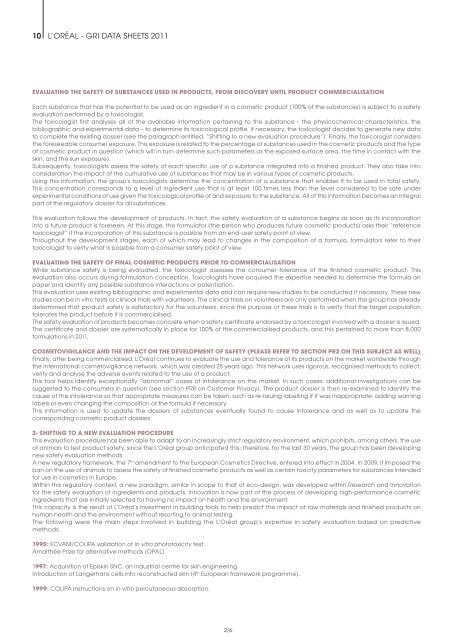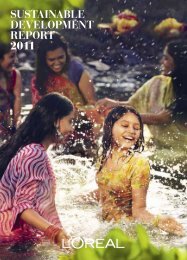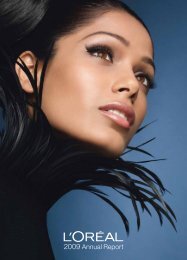Organizational Strategy - Sustainable Development - L'Oréal
Organizational Strategy - Sustainable Development - L'Oréal
Organizational Strategy - Sustainable Development - L'Oréal
You also want an ePaper? Increase the reach of your titles
YUMPU automatically turns print PDFs into web optimized ePapers that Google loves.
10 L’oréaL - GrI DaTa SHEETS 2011<br />
EVALUATING THE SAFETY OF SUBSTANCES USED IN PRODUCTS, FROM DISCOVERY UNTIL PRODUCT COMMERCIALISATION<br />
Each substance that has the potential to be used as an ingredient in a cosmetic product (100% of the substances) is subject to a safety<br />
evaluation performed by a toxicologist.<br />
The toxicologist first analyses all of the available information pertaining to this substance - the physicochemical characteristics, the<br />
bibliographic and experimental data – to determine its toxicological profile. If necessary, the toxicologist decides to generate new data<br />
to complete the existing dossier (see the paragraph entitled, “Shifting to a new evaluation procedure”). Finally, the toxicologist considers<br />
the foreseeable consumer exposure. This exposure is related to the percentage of substances used in the cosmetic products and the type<br />
of cosmetic product in question (which will in turn determine such parameters as the exposed surface area, the time in contact with the<br />
skin, and the sun exposure).<br />
Subsequently, toxicologists assess the safety of each specific use of a substance integrated into a finished product. They also take into<br />
consideration the impact of the cumulative use of substances that may be in various types of cosmetic products.<br />
Using this information, the group’s toxicologists determine the concentration of a substance that enables it to be used in total safety.<br />
This concentration corresponds to a level of ingredient use that is at least 100 times less than the level considered to be safe under<br />
experimental conditions of use given the toxicological profile of and exposure to the substance. all of this information becomes an integral<br />
part of the regulatory dossier for all substances.<br />
This evaluation follows the development of products. In fact, the safety evaluation of a substance begins as soon as its incorporation<br />
into a future product is foreseen. at this stage, the formulator (the person who produces future cosmetic products) asks their “reference<br />
toxicologist” if the incorporation of this substance is possible from an end-user safety point of view.<br />
Throughout the development stages, each of which may lead to changes in the composition of a formula, formulators refer to their<br />
toxicologist to verify what is possible from a consumer safety point of view.<br />
EVALUATING THE SAFETY OF FINAL COSMETIC PRODUCTS PRIOR TO COMMERCIALISATION<br />
While substance safety is being evaluated, the toxicologist assesses the consumer tolerance of the finished cosmetic product. This<br />
evaluation also occurs during formulation conception. Toxicologists have acquired the expertise needed to determine the formula on<br />
paper and identify any possible substance interactions or potentiation.<br />
This evaluation uses existing bibliographic and experimental data and can require new studies to be conducted if necessary. These new<br />
studies can be in vitro tests or clinical trials with volunteers. The clinical trials on volunteers are only performed when the group has already<br />
determined that product safety is satisfactory for the volunteers, since the purpose of these trials is to verify that the target population<br />
tolerates the product before it is commercialised.<br />
The safety evaluation of products becomes concrete when a safety certificate endorsed by a toxicologist involved with a dossier is issued.<br />
The certificate and dossier are systematically in place for 100% of the commercialised products, and this pertained to more than 8,000<br />
formulations in 2011.<br />
COSMETOVIGILANCE AND THE IMPACT ON THE DEVELOPMENT OF SAFETY (PLEASE REFER TO SECTION PR2 ON THIS SUBJECT AS WELL)<br />
Finally, after being commercialised, L’oréal continues to evaluate the use and tolerance of its products on the market worldwide through<br />
the international cosmetovigilance network, which was created 25 years ago. This network uses rigorous, recognised methods to collect,<br />
verify and analyse the adverse events related to the use of a product.<br />
This tool helps identify exceptionally “abnormal” cases of intolerance on the market. In such cases, additional investigations can be<br />
suggested to the consumers in question (see section Pr8 on Customer Privacy). The product dossier is then re-examined to identify the<br />
cause of this intolerance so that appropriate measures can be taken, such as re-issuing labelling if it was inappropriate, adding warning<br />
labels or even changing the composition of the formula if necessary.<br />
This information is used to update the dossiers of substances eventually found to cause intolerance and as well as to update the<br />
corresponding cosmetic product dossiers.<br />
2- SHIFTING TO A NEW EVALUATION PROCEDURE<br />
This evaluation procedure has been able to adapt to an increasingly strict regulatory environment, which prohibits, among others, the use<br />
of animals to test product safety, since the L’oréal group anticipated this; therefore, for the last 30 years, the group has been developing<br />
new safety evaluation methods.<br />
a new regulatory framework, the 7 th amendment to the European Cosmetics Directive, entered into effect in 2004. In 2009, it imposed the<br />
ban on the use of animals to assess the safety of finished cosmetic products as well as certain toxicity parameters for substances intended<br />
for use in cosmetics in Europe.<br />
Within this regulatory context, a new paradigm, similar in scope to that of eco-design, was developed within research and Innovation<br />
for the safety evaluation of ingredients and products. Innovation is now part of the process of developing high-performance cosmetic<br />
ingredients that are initially selected for having no impact on health and the environment.<br />
This capacity is the result of L’oréal’s investment in building tools to help predict the impact of raw materials and finished products on<br />
human health and the environment without resorting to animal testing.<br />
The following were the main steps involved in building the L’oréal group’s expertise in safety evaluation based on predictive<br />
methods.<br />
1995: ECVaM/CoLIPa validation of in vitro phototoxicity test.<br />
amalthée Prize for alternative methods (oPaL).<br />
1997: acquisition of Episkin SNC, an industrial centre for skin engineering.<br />
Introduction of Langerhans cells into reconstructed skin (4 th European framework programme).<br />
1999: CoLIPa instructions on in vitro percutaneous absorption.<br />
2/6






